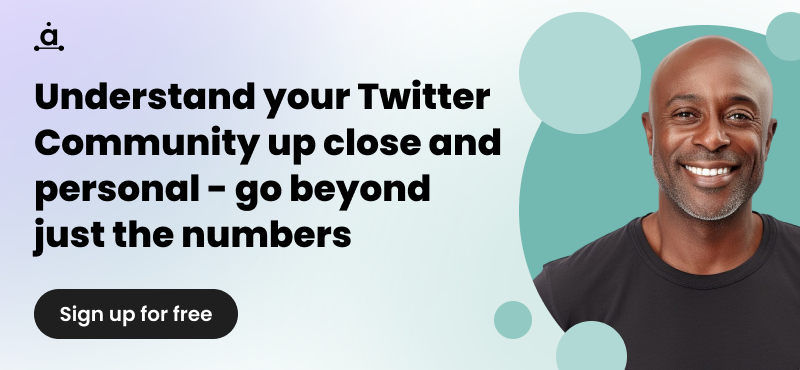How to analyze your competition in Twitter
If your brand is on Twitter, you may think that you’re doing enough by sending out tweets regularly and engaging with your followers. But what if your competitors are doing far better than you? What are they doing differently that’s resulting in their success? And how far are you falling behind? Keeping a close eye on the competition is crucial if you want to build and maintain a strong Twitter presence and use it as a channel to get ahead of the competition.
In this post, we take a closer look at Twitter competitor analysis, why it’s important, and how you can conduct your own. Let’s get started.
- What Is Twitter Competitor Analysis?
- Why Conduct a Twitter Competitive Analysis?
- How to Conduct a Twitter Competitor Analysis
- Getting Started with Your Twitter Competitor Analysis
What is Twitter competitor analysis?
Twitter competitor analysis is the process of studying your competitors on Twitter, in the simplest of terms. It involves keeping an eye on their performance and their activities on the platform and using those insights to understand where you stand compared to them.
A Twitter analysis of your competitor can help you determine things like how many followers your competitors have, how frequently they post, what kind of audience distribution they have, and how much influence they’ve garnered over the years.
Why conduct a Twitter competitive analysis?
Regularly checking in on your competitors will give you a variety of insights to help you gain a competitive edge. You should run a Twitter competitor analysis because it allows you to:
Identify new/emerging competitors
A comprehensive competitor analysis can uncover some of the leading competitors for your business. This may include competitors you already know of and those you may not be aware of, as well as brands that just entered the market and are quickly catching up.
Benchmark your performance
An obvious benefit of Twitter competitor analytics is in comparing your own performance against leaders in the industry. This will show you how far behind you are in the race, whether there are any gaps in your existing strategy, and what you need to do to catch up.
See what’s working for your competitors
Perhaps one of the best ways to use a Twitter competitor analysis is to check their current social strategy. What types of content are they sharing? How are they engaging with their audience? What kind of campaigns are they running? How are they driving traffic to their websites?
This will help you narrow down on the tactics that are working for your competitors so you can replicate them for your own Twitter strategy.
Find opportunities to get ahead
Analysing your competitors’ Twitter strategy will also help you identify their shortcomings and untapped opportunities that you can leverage to get ahead. Are they leaving customers in the lurch who make public complaints? Should they be posting more often? Or are they tweeting too much content that don’t add value?
How to conduct a Twitter competitor analysis
Running a Twitter competitor analysis involves a few essential steps:
Step 1: Identify your top competitors on Twitter
Start by making a list of the competitors you want to analyse on Twitter. What are the leading names in your niche? Try running a Google search using your target keywords and see which names come up. Also run a search on Twitter using hashtags and keywords relevant to your industry to see which brands are leading the conversations.
Step 2: Keep track of the basics
Next, start tracking the basic performance metrics to get an overview of how you measure up against the competition on Twitter. This involves tracking metrics like follower count, following size, and number of tweets per day.
You can use the Audiense Connect platform to run this analysis with up to three accounts. The platform will let you track all these basic metrics as well as follower-to-following ratio, which is a good measure of influence.

Step 3: Analyse their audience
Once you analyse the basics, it’s also important to go a bit more in-depth with your Twitter competitor analysis. Find out what kind of demographics make up your competitors’ follower base. Are they getting tons of engagement with a particular audience group? Is there an audience segment that you’ve failed to target through your Twitter marketing efforts? Analysing your competitors’ Twitter audience can give you the answer to these important questions.
Step 4: Study their content
While having a brief overview of Tweet volume and frequency is crucial, you also need to go in-depth to understand exactly what type of content your competitors are leveraging. Are they making a lot of text posts? Or are they sharing images and videos? Are they curating content from other websites? Or do they focus on creating original content?
Is there a certain type of content they’re not leveraging enough? More importantly, which of their content is getting the most engagement? And how well is this content strategy working out for them? All of these questions can give you a better idea of how to update your Twitter content strategy to gain a competitive edge.
Step 5: Observe their engagement strategy
Next, take a closer look at how your competitors are engaging with their audience. How are they responding to comments? Are they retweeting brand mentions? How often do they create polls to drive follower growth?
Understanding the answers to these questions will give you an idea of how to optimise your own Twitter strategy to garner better engagement. This could involve replicating your competitors’ successful strategies or leveraging any missed opportunities for engagement that you found during your analysis.
Getting started with your Twitter competitor analysis
If you’re starting out with Twitter competitor analytics, you can use a platform like Audiense Connect to streamline your efforts. The platform provides you with robust tools to monitor your Twitter performance and manage your community. In addition, you can also use it to run a comprehensive Twitter competitor analysis.
Here are a few tools to help you get started with Audiense Connect:
Account comparison
This tool lets you compare up to three Twitter accounts, making it perfect for competitor analytics. You can access this tool from the “Analytics” drop-down menu. To create a new comparison report, click on the “New Comparison” button and select the two or three accounts you want to compare.
In the report, you’ll get a summary of the main comparison metrics such as – followers, following, member since, tweets, ratio, and tweets per day. You also get more in-depth comparison reports to find out how your followers have grown over the months, what primary languages each community speaks, how many users have custom vs. default avatars, and more.

Audience intersection
Another useful tool is the Audience Intersection Report, which gives you a snapshot of how the audiences of different accounts intersect. It shows you the number of followers you have in common with your competitors and the number of exclusive followers each account has. This will show you the affinity shared between your audience and your competitors’ audience, so you can identify untapped audience segments and gain insights on how to better target specific segments.

The takeaway
Regular Twitter competitor analytics should be an essential part of your overall marketing and brand strategy as the insights you get aren’t just applicable to social media. You’ll discover actionable ways to stand apart from the competition in everything from marketing and sales to product development and customer service.
If you’re looking for new ways to make Twitter work for you, try Audiense Connect. We’re the #1 Twitter marketing platform, with a range of features spanning everything from chatbot integration to audience segmentation. Find out more about Audiense here, or get in touch to speak to a member of the team.





.png?width=60&name=image%20(62).png)
